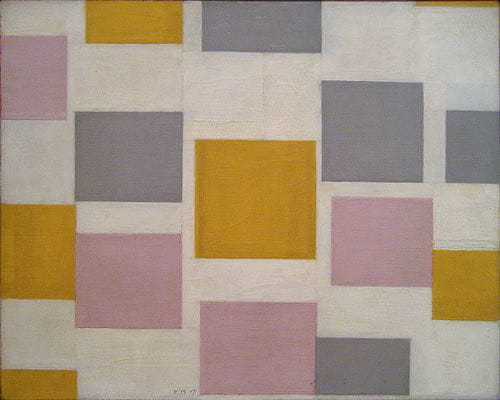In our input with Anna, we learnt that there are many different aspects of maths within art. It was very interesting to learn about and see for ourselves.
The first activity that we took part in was drawing in the style of Mondrian. Piet Mondrian (1872 – 1944) was one of the founders of the Dutch movement De Sijl (The Art Story, n.d, b). De Stijl was an avant-garde style, that was appropriate to all aspects of modern life, from art to architecture (The Art Story, n.d., a). Mondrian was best known for being simplistic, using lines and rectangles to create his paintings.

Here is one of Mondrian’s abstract paintings.
I then had a go at drawing my own Mondrian inspired piece of work. I started off by drawing two parallel lines about 9cm apart. I then began to draw lines within the first two lines, both vertically and horizontally, which created rectangles. I then coloured in some of the rectangles that were created and this was the result:

Here is my own interpretation of a Mondrian style of artwork.
The next thing we looked at was the Fibonacci sequence. This sequence starts with 0, and is when the two previous numbers add up to the following number, so it goes: 0, 1, 1, 2, 3, 5, 8, 13, 21, 34, 55, 89…etc. When this sequence is drawn out in squares, it makes spiral, also known as the ‘Golden Ratio’. This video looks at Fibonacci’s sequence and how it is found in nature. It also talks about the golden ratio and its relevance to Fibonacci’s sequence.
The golden ratio is the number 1.618033, also known as phi (Φ). This number is found by the formula (a+b)/a = a/b . This relates to Fibonacci’s sequence, as ratio of each successive pair of numbers in the sequence approximates Phi (1.618. . .), as 5 divided by 3 is 1.666…, and 8 divided by 5 is 1.60 (Meisner, 2012, b). Phi was first used by Greek sculptor and mathematician, Phidias (Meisner, 2012, a). It was Euclid that first talked about Phi as taking a line and separating it into two, in a way that the ratio of the shortest segment to the longest will be the same ratio of the longest to the original line (Bellos, 2010).
The golden ratio was first called the ‘Divine Proportion’ in the 1500’s. Many people believed that by taking measurements of your body, and then using the formula of phi, you were beautiful if the result was 1.60. We had a try at this ourselves by measuring:
- Distance from the ground to your belly button
- Distance from your belly button to the top of your head
- Distance from the ground to your knees
- Length of your hand
- Distance from your wrist to your elbow
Then we had to divide:
- Distance from the ground to your belly button by distance from your belly button to the top of your head
- Distance from the ground to your belly button by distance from the ground to your knees
- Distance from your wrist to your elbow by length of your hand
Some of the results i got were 1.7 which is very close to the golden ratio, and others were way off with results of nearly 2.1.
Many Renaissance artists used the golden ratio in their paintings to achieve beauty. For example, Leonardo Da Vinci used it to define all the fundamental proportions of his painting of “The Last Supper,” from the dimensions of the table at which Christ and the disciples sat to the proportions of the walls and windows in the background (Meisner, 2012, a).

Here is how Da Vinci has used the golden ratio in two of his most famous paintings.
The golden ratio and Fibonacci’s sequence is also a prominent feature in nature, as mentioned in the video before. Here are some more examples:

Fibonacci’s sequence in the bones of a human hand.

The golden spiral in a hurricane.

Even our own galaxy that we live in is made up of Fibonacci’s sequence.
I found this input incredibly interesting and will definitely be taking what I learned into the classroom. This input has definitely benefited me in not only seeing the link between maths and art, but also with nature, science, and much more. . Moving forward, I can see the possible cross-curricular activities that can be undertaken with maths, linking it with art or science, by creating our own artwork using Fibonacci’s sequence or looking at how plants grow in particular ways that link to the golden ration. Overall, I thoroughly enjoyed this input and can’t wait to look at it again.
References
Bello, Alex (2010) Alex’s Adventures in Numberland London: Bloomsbury
Meisner, G. (2012, a). History of the Golden Ratio. [Online]. Available at: https://www.goldennumber.net/golden-ratio-history/ [Accessed 24th November 2017].
Meisner, G. (2012, b). What is the Fibonacci Sequence (aka Fibonacci Series)?. [Online] Available at: https://www.goldennumber.net/fibonacci-series/ [Accessed 24th November 2017].
Memolition. (No Date). Examples Of The Golden Ratio You Can Find In Nature. [Online] Available at: http://memolition.com/2014/07/17/examples-of-the-golden-ratio-you-can-find-in-nature/ [Accessed 24th November 2017].
Robb, A. (2017) Maths and Art. [PowerPoint Presentation] ED21006: Discovering Mathematics [Accessed 24th November 2017]
The Art Story. (No Date, a). De Stijl Movement, Artists and Major Works. [Online] Available at: http://www.theartstory.org/movement-de-stijl.htm [Accessed 23rd November 2017].
The Art Story. (No Date, b). Piet Mondrian Biography, Art, and Analysis of Works. [Online] Available at: http://www.theartstory.org/artist-mondrian-piet.htm [Accessed 23rd November 2017].
TheJourneyofPurpose (2013) Fibonacci Sequence in Nature [Online]. YouTube. Available at: https://www.youtube.com/watch?v=nt2OlMAJj6o [Accessed 24th November 2017]


May I use your picture of the fibonacci spiral galaxy for a presentation at my school where I work as a teacher and at a math course at Karlstad university where I am a student?
Kind regards
Björn Smith